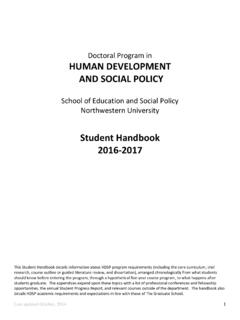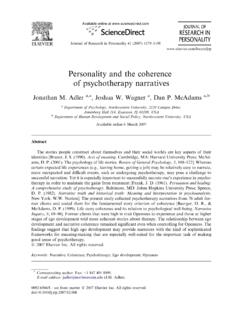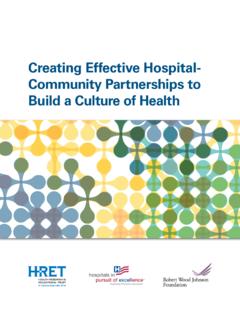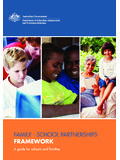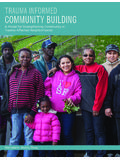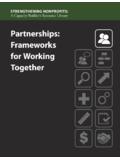Transcription of DISCOVERING COMMUNITY POWER
1 DISCOVERING COMMUNITY POWER : A GUIDE TO MOBILIZING LOCAL ASSETS AND YOUR. ORGANIZATION'S CAPACITY. A COMMUNITY - building Workbook from the Asset-Based COMMUNITY Development Institute School of Education and Social Policy Northwestern University 2120 Campus Drive Evanston, IL 60208-4100. John P. Kretzmann and John L. McKnight, Co-Directors By John P. Kretzmann and John L. McKnight, Co-Directors with Sarah Dobrowolski, Project Coordinator and Deborah Puntenney, 2005 by the ABCD Institute Acknowledgments Acknowledgments Funded by the Kellogg Foundation, the Asset-Based COMMUNITY Development (ABCD) Institute developed DISCOVERING COMMUNITY POWER : A.
2 Guide to Mobilizing Local Assets and Your Organization's Capacity.. Please note: although this document is copyrighted, permission for use will be granted upon notification of intended use to the ABCD Institute. Please email the ABCD Institute with the name of your group or organization and a brief description of how you plan to use the Guide. This information will help us with future research and evaluation. The Guide is available to download freely on the Kellogg Foundation's website: and the ABCD Institute's website: A COMMUNITY building Workbook 2005 Asset-Based COMMUNITY Development Institute Introduction 1.
3 Introduction Strengthening Your Proposal And Your Organization . By Connecting With COMMUNITY Assets The Kellogg Foundation is very interested in proposals that both improve the COMMUNITY and strengthen the applicant organization. Our experience indicates that proposals which connect with and engage a wide range of COMMUNITY resources are more effective than those which involve only the staff of the lead organization. We are also convinced that non-profit organizations are much more powerful COMMUNITY actors when they are not exclusively focused on needs, problems, and deficiencies but are effectively connected to the resources, or assets, of the local COMMUNITY .
4 This document will help any organization: 1. Strengthen its own organization by enhancing connections with the COMMUNITY 's assets. 2. Strengthen the COMMUNITY by investing in the COMMUNITY 's assets. 3. Strengthen current and future COMMUNITY based projects, activities, and proposals. The following pages are divided into three sections to help applicants connect with COMMUNITY assets. Section One How to assess and strengthen your proposal's relationships with and utilization of COMMUNITY assets; and Section Two How to identify and connect your non-profit organization's assets to this project. Section Three Tools which may be helpful in connecting both projects and organizations to COMMUNITY assets.
5 Section Four Information about the ABCD Institute. In Section One of this manual, we will introduce a series of questions designed to guide your reflections about a proposal's relationships to five categories of COMMUNITY assets. These include: 1. Local residents their skills, experiences, passions, capacities and willingness to contribute to the project. Special attention is paid to residents who are sometimes marginalized . A COMMUNITY building Workbook 2005 Asset-Based COMMUNITY Development Institute 2 Introduction 2. Local voluntary associations, clubs, and networks , all of the athletic, cultural, social, faith-based, etc.
6 Groups powered by volunteer members . which might contribute to the project. 3. Local institutions- public institutions such as schools, libraries, parks, police stations, etc., along with local businesses and non-profits which might contribute to the project. 4. Physical assets the land, the buildings, the infrastructure, transportation, etc. which might contribute to the project. 5. Economic assets what people produce and consume, businesses, informal economic exchanges, barter relationships, etc. In Section Two, we will provide questions to guide you in asking about your own organization's wide range of assets, and their relationship to the proposed project.
7 In Section Three, you will find additional tools and illustrations to help you connect your proposal and your organization with COMMUNITY assets. In Section Four, you will find information about the ABCD Institute. Throughout this document you will see several symbols repeated: When you see this symbol, what follows is a really important idea. * When you see this symbol, what follows is the location of the page on which you can find additional information. A COMMUNITY building Workbook 2005 Asset-Based COMMUNITY Development Institute Introduction 3. Producing Strong COMMUNITY -Based Projects This document is based on the following simple equation: Your COMMUNITY 's Assets Connected To (+).
8 Your Organization's Assets Produces (=). Strong COMMUNITY -Based Projects A COMMUNITY building Workbook 2005 Asset-Based COMMUNITY Development Institute Section I: 4. An Asset-Based Framework to Explore Your Project Section I. Index How to assess and strengthen your proposal's relationships with and utilization of COMMUNITY assets. Page 5: Relationships with Local Residents Page 6: Relationships with Residents Who are Often Marginalized Pages 7-8: Relationships with Associations Pages 9-10: Relationships with Institutions Page 11: Relationships with Physical Space Pages 12-13: Relationships with the Local Economy Page 14: A Bridge to Resources Outside the Local COMMUNITY Page 15: A Sample COMMUNITY Asset Map Page 16: Your COMMUNITY Asset Map Page 17: Connecting Your COMMUNITY 's Assets to this Project A COMMUNITY building Workbook 2005 Asset-Based COMMUNITY Development Institute 5 Section I.
9 An Asset-Based Framework to Explore Your Project Relationships with Local Residents: Sustainable projects are often powerfully related to the involvement of residents. Example: In many communities, resident skills and interests are uncovered through the use of skills surveys or capacity inventories. These communities discover that everyone has gifts to contribute which can strengthen the COMMUNITY . * For sample capacity inventories, see Section 3, pages 23-24. Below are questions which gauge your project's interaction with local residents. Our project mobilizes the skills and capacities of local residents.
10 Not at All Some A Great Deal 1 2 3 4 5. Describe: Our project works to enhance the skills and capacities of local residents. Not at All Some A Great Deal 1 2 3 4 5. Describe: Local residents help define our project objectives. Not at All Some A Great Deal 1 2 3 4 5. Describe: Local residents will act as: * For definitions of these roles, see Section 3, Page 25. Recipients Information Sources Participants In Control Describe: A COMMUNITY building Workbook 2005 Asset-Based COMMUNITY Development Institute Section I: 6. An Asset-Based Framework to Explore Your Project Relationships with Residents Who are Often Marginalized: Communities are strengthened when organizations encourage and support diversity.
